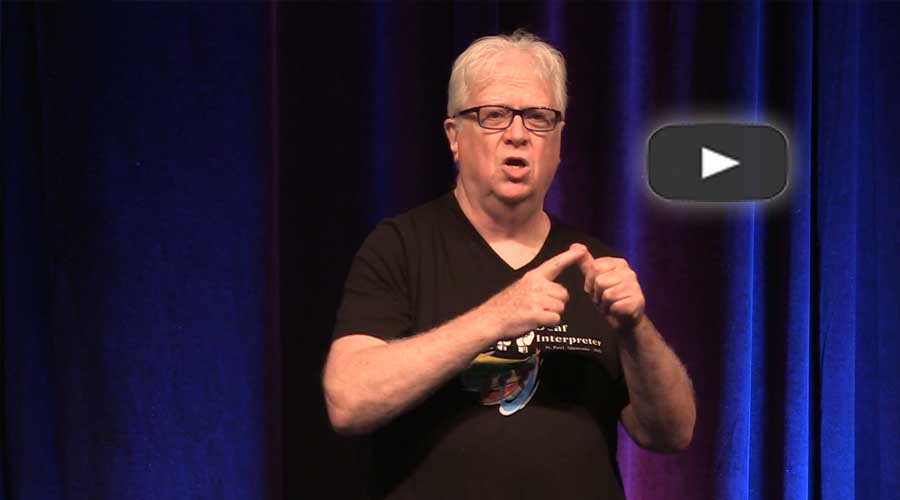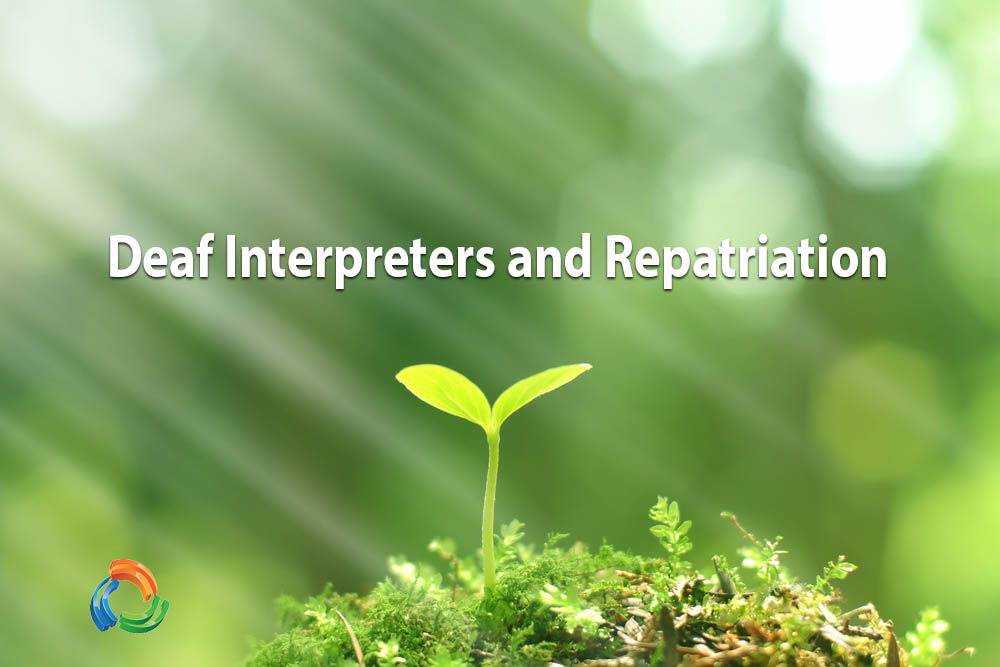
Ray Kenney presented Deaf Interpreter Conference Finish: Do Do Now? at StreetLeverage – X | RID Conference 2015. His presentation provides an insider’s view from the historic Deaf Interpreter Conference held in June 2015.
You can find the PPT deck for his presentation here.
[Note from StreetLeverage: What follows is an English rendition of Ray’s talk from StreetLeverage – X | RID Conference 2015. We would encourage each of you to watch the video and access Ray’s talk directly.]
StreetLeverage – X
I would like to thank Sandra Maloney, Betty M. Colonomos, and Erica West Oyedele, the presenters before me here at StreetLeverage-X. They said many of the things I had planned to say, so I do not need to repeat it.
How many of you here today went to the Deaf Interpreter Conference (DIC)? I see quite a few. Forgive me for doing this on stage but I am proud to show this off…this is my tee shirt from the conference. It helps me feel connected. (To see the StreetLeverage coverage of the conference, please click here.)
Big thanks to all the committee members, Jimmy Beldon and Janis Cole for taking the lead to make the Deaf Interpreter Conference a reality. The committee communicated only with Glide using ASL – no emails or texting. The committee would get anywhere from few messages a day to hundreds a day as the Conference drew nearer. They accomplished this huge task in less than 6 months.
Deaf Interpreter Conference
This historic conference, the first of its kind, took place June 20-24, 2015 at St. Catherine University, in St. Paul, Minnesota. Everyone involved was Deaf, the only hearing people I saw were probably the cafeteria staff.
The Conference drew 208 attendees: some CDIs, DIs with experience, and others with no experience. Many of the attendees without experience wanted to become DIs but were not sure how to do it. The DIC had three workshop tracks: Advanced, Beginner and Mixed, so there was something for everyone who attended. Topics presented there are similar what you would find at the RID Conference: Legal, Medical, the mechanics of interpreting, where to go for training; detailed, specialized topics as well as more global topics were covered.
On opening day, the conference held a reframing workshop where we came up with CELT. This concept became our theme for the rest of the conference. I will explain that in a moment, but first understand that when we first arrived, there was a bit of awkwardness as we met, discovered who was there, why they were there, etc. CELT is Compassion, Empathy, Listening and Transparency, and it became our motto for the week. Though the conference only lasted 5 days, it felt like a week!
Another consistent theme that ran throughout the week was the need to educate- educate Hearing interpreters, consumers, everyone.
Characteristics of Deaf Interpreters (DIs) and Hearing Interpreters (HIs)
I have two slides I will be showing you comparing Deaf interpreters (DIs) to Hearing interpreters (HIs).
Themes: DI
What are some characteristics of DIs? DIs are Lifelong Interpreters: we have been interpreters most of our lives. I remember when I was about seven years old, I was in class with several Deaf classmates. The teacher was trying to teach us some lesson. As soon as the teacher turned her back, someone would ask me what she had just said. We would discuss/collaborate/interpret the lesson. We found that was a common experience shared by many of us at DIC: we all relied on each other to understand what was said. These experiences ingrained that role in us and led most of us to continue the practice in the form of the role of DI.
Deaf norms:
I am sure many of you are familiar with Deaf Norms, but one example is the need to have collaborative discussions to understand what is said. This is not true for Hearing people. This dialogical approach is utilized by most experienced DIs as we work with consumers.
Although a Deaf person commonly engages in conversation with the DI, this is not typical for many HIs. While the DI is engaged with the Deaf person, the DI takes in more messages and questions via the HI. We simply keep the dialogue going and incorporate the new information in our conversation. The concept of an interpreter as the conveyor of messages between consumers, without dialogue, is not the norm with DIs. Nor is the idea that if the Deaf person doesn’t understand something – too bad! This shift to a dialogic approach to interpreting was validated for me at the conference.
In our conversations through the week, we noted a major difference when a DI interprets the Deaf person’s message to the HI. With a DI present, the Deaf person can see the DI’s interpretation and, if needed, correct the information/message. If a DI is not present, the Deaf person never knows if they were understood or if their message was properly interpreted to the Hearing person. This is one critical piece that is missing in more typical interpreting situations. This lack of access has lead to much abuse of power and privilege.
In discussions about our expectations of the HI, particularly in terms of language, there was no consensus among DIC attendees. When considering DIs’ preferences in terms of the language used by HI, styles of interpreting vary from job to job. Some assignments may be at a much higher register than others. The message is the same regardless of how it is conveyed.
Conference attendees also explored ways DIs/HIs might collaborate as a team. One point of consensus was that team members must make agreements prior to the job.
Themes: HI
Of course, much discussion took place about Hearing interpreters throughout the week. Complaints were raised, for sure, but I want to focus on the qualities of HIs that enhance our work as DIs. We are all learning to be collaborators in the interpreting process.
One practice DIs appreciate is when the HI trusts the DI to handle the on-site introductions. This approach alleviates the awkwardness that occurs when the HI tries to explain “who we are,” etc., while signing simultaneously. The DI can introduce the team and explain the process while the HI interprets providing simultaneous explanation to both the Hearing and Deaf person. Developing a rapport between the HI and DI is key for this kind of confidence to develop.
I want to acknowledge Amy Williamson for sharing the concept of “Brokering” at the 2015 Street Leverage Live event I attended in Boston. She provided a term for what we do: this process of working together to communicate the information/message to both Deaf and Hearing parties.
Another characteristic DIs appreciate is the willingness to “Pre-Brief” before a job. I don’t think “pre-brief” is a word in English, but I am using it to describe the meeting that should take place before we begin to interpret. Typically, DIs also like to debrief after the job is completed.
How much time do I have left? (Presenter asks timekeeper at the session.)
StreetLeverage – X Reflection
I want to reflect on the previous presenters and how their presentations connect to what took place at DIC.
Sandra Maloney talked about the “Extraction Mindset” – thinking outside of the box and being open to new ideas. This relates to a wish many DIs expressed at DIC: DIs wish to be welcomed by HIs. We want to work with you. Yes, DIs have our preferences but we recognize the need to be more flexible and learn to work with all HIs.
Betty Colonomos’ concept of gatekeeper is also relevant. At DIC, we discussed this very topic and believe it should be the responsibility of the DIs to manage gatekeeping. Invite DIs to be part of the team and we will take care of the gatekeeping. The key word Betty uses is respect. Respect the fact that DIs are here. Mutual respect for each other and our work will go a long way instead of being treated like extra, unnecessary baggage.
Erica West Oyedele’s topic, People of Color, brought to mind many similarities between POC and Deaf people. Like the Black community, Deaf people, including myself, are angry. We are finding power in talking with each other. I have had HIs describe the sigh of relief they hear from the Deaf person when they realize a DI is there. I’ve experienced this sigh of relief before going into court when the Deaf consumer realized that I was deaf and would be there for him. That should tell you something.
In Closing
The need to educate is not new. Universities, even in the present day, have resisted including Deaf people in their interpreter education programs. This needs to stop. Deaf interpreting must be included in interpreter preparation programs, both in training Deaf people to become interpreters and in teaching the hearing students what DIs do and how to work with us. If you open the door to DIs, we will help all interpreters improve by learning how we can team and work together. As it is today, I personally do not know how to team with some of you HIs.
I guarantee you will be seeing more of us, both out there in the community and at our conferences. It is unfortunate that the 2015 RID conference fell right after DIC as many DIs were not able to attend both conferences.
Thank you.





